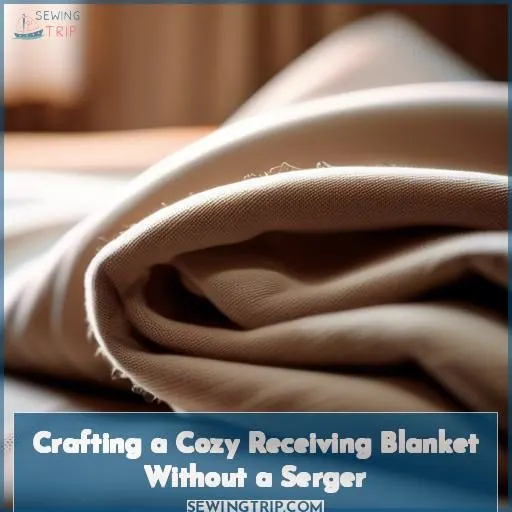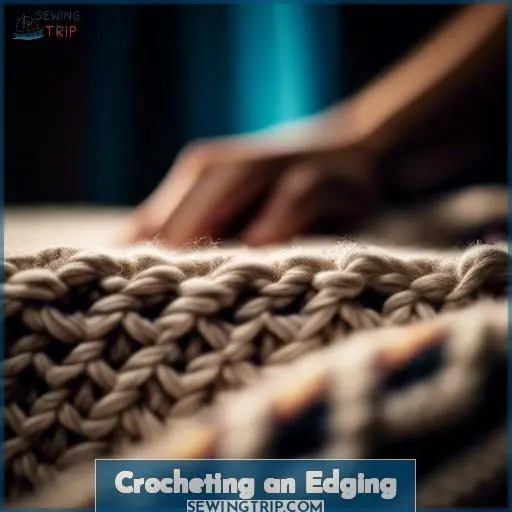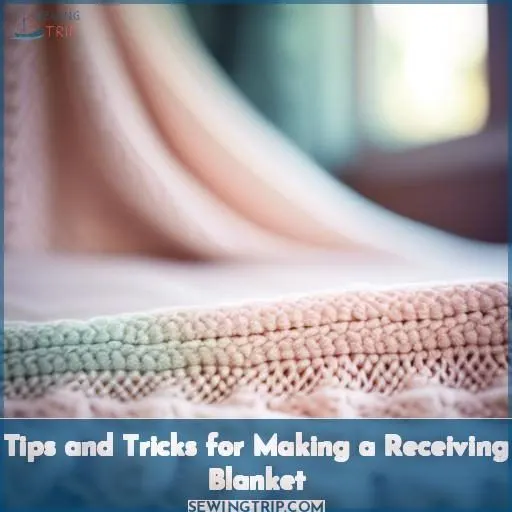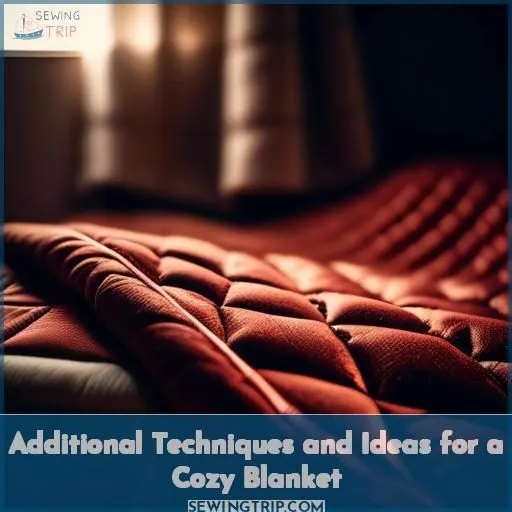This site is supported by our readers. We may earn a commission, at no cost to you, if you purchase through links.

To make a receiving blanket without a serger, you can fold the edges over twice. This helps to prevent unraveling and adds a clean finish to the blanket.
Using a different type of sewing machine, such as a zigzag or overlock stitch, can also help to prevent unraveling and create a professional-looking edge.
Crocheting an edging adds a decorative touch and can be done using a variety of stitch patterns and yarns.
Additionally, when making a receiving blanket, consider using soft, breathable fabric, following care instructions, and adding personal touches to make it special.
To learn more about creating a cozy and functional receiving blanket without a serger, continue reading.
Table Of Contents
Key Takeaways
- Folding the edges over twice is a method to prevent unraveling and add a clean finish to a receiving blanket.
- Using a different type of sewing machine, such as a zigzag or overlock stitch, can help prevent unraveling and create a professional-looking edge.
- Crocheting an edging adds a decorative touch and can be done using a variety of stitch patterns and yarns.
- When making a receiving blanket, consider using soft, breathable fabric, following care instructions, and adding personal touches to make it special.
How to Make a Receiving Blanket Without a Serger?
To make a receiving blanket without a serger, you can fold the edges over twice and hem. This method will result in a slightly bulkier edge compared to using a serger, but it’s still effective.
You can use a regular sewing machine to overlock the edges with a zigzag stitch if you don’t have a serger. Additionally, you can use a turn-under foot on your sewing machine to create a finished serged edge.
Folding the Edges Over Twice
To create a snuggly receiving blanket without a serger, you can fold the edges over twice. This method provides a neat finish and helps prevent puffiness at the corners. Here’s a step-by-step guide:
- Prepare the Edges: Start by pressing the edges you want to fold. This will help you create a crisp crease that will guide your stitching later on.
- Fold the Edges: Fold the edge inwards, creating a double fold. The first fold should be about 1/4 inch from the raw edge, and the second fold should be about 1/2 inch from the raw edge.
- Miter the Corners: To create a neat corner, miter the edges so that the folded edges meet at a 45-degree angle. This can be done by folding the edge diagonally toward the wrong side of the fabric.
- Iron the Edges: After folding, press the edges to create a sharp crease. This will help guide your stitching and make sure a neat finish.
- Stitch the Edges: Using a sewing machine, stitch along the folded edge to secure the folds in place. Be sure to backstitch at the beginning and end of the stitching to make sure a strong hold.
- Trim the Excess: To minimize bulk, trim the excess fabric at the corner point, cutting diagonally.
- Press the Edges: Finally, press the edges one last time to make sure a smooth, flat finish.
Using a Different Type of Sewing Machine
In the endeavor of constructing a comforting receiving blanket without a serger, employing an alternative sewing machine can bring about a marked improvement. Instead of utilizing a serger for the purpose of seam finishing, you can opt for a conventional sewing machine with certain adaptations.
Firstly, give thought to the fabric you select. If you’re working with a lightweight material, such as cotton, it may be advisable to adjust your thread choice to correspond with the fabric’s hue. For more substantial fabrics, such as flannel, you may require a more robust thread.
Subsequently, pay meticulous attention to your seam allowance. A standard seam allowance of 3/8-inch is suitable for the majority of projects, but you can modify this based on the thickness of your fabric. Be certain to press your seams open after sewing to attain a crisp edge.
Do not overlook the potential of decorative stitching! A zigzag stitch or an ornamental border can impart a personal touch to your blanket. Simply ensure that you utilize a thread that harmonizes with the color of your fabric.
Crocheting an Edging
Crocheting an edging is a great way to add a personal touch to your receiving blanket. It’s a simple technique that can make your blanket look more polished and cozy. First, consider your yarn choice**. A soft, breathable yarn like cotton or linen is perfect for a receiving blanket. Next, think about the hook size. A larger hook will create a looser stitch, while a smaller hook will create a tighter stitch. Experiment with different hook sizes to find the one that suits your preference.
For the stitch pattern, a simple double crochet (dc) stitch is a good choice. It’s easy to learn and creates a nice texture. You can also try a shell stitch or a shell stitch with a dc in between for a more intricate pattern. If you want to add a decorative trim, consider using a contrasting color or a different type of yarn. This will add visual interest and make your blanket stand out. Remember, the key to a great edging is to be consistent with your stitches and to keep your tension even. With a little practice, you’ll have a beautiful edging that will make your receiving blanket even more special.
Tips and Tricks for Making a Receiving Blanket
Crafting a cozy receiving blanket without a serger can be a fun and rewarding experience. Here are some tips and tricks to help you make the perfect blanket:
- Choosing the Right Fabric: Select a soft, breathable fabric like cotton or flannel. Aim for a weight that’s suitable for a receiving blanket, typically around 100-150 grams per square meter.
- Picking the Perfect Pattern: Consider the recipient’s taste and the occasion. A simple, timeless pattern like a stripe or polka dot can be a safe choice.
- Selecting Suitable Thread: Use a high-quality, all-purpose thread that matches the color of your fabric. A 100% cotton thread is a good choice.
- Washing and Care Instructions: Always read and follow the care instructions on your fabric. Hand wash or machine wash on a gentle cycle, then dry on low heat.
Additional Techniques and Ideas for a Cozy Blanket
Firstly, contemplate adding stitched appliques or decorative embroidery to your blanket. This not just adds a personal touch but also creates an aesthetically pleasing design. For a more whimsical look, you can add tasseled edging or fluffy embellishments. If you’re feeling especially creative, you can even stitch squares together for an extra layer of warmth and texture. Remember, the secret to a cozy blanket lies in the little details, so don’t hesitate to unleash your creativity!
Frequently Asked Questions (FAQs)
Can I use a regular sewing machine to make a receiving blanket without a serger?
Yes, you can make a receiving blanket without a serger using a regular sewing machine. To create a finished edge, you can roll each edge under twice and sew in a straight line.
This method will give you a neat, finished edge that’s suitable for a receiving blanket. If you prefer a more bulky edge, you can fold the edges over twice and hem down the perimeter.
Alternatively, if you have access to a serger, you can use it to create a rolled hem, which will give you a neater finish.
How do I properly fold the edges over twice for a receiving blanket without a serger?
To make a receiving blanket without a serger, you can fold the edges over twice and hem them down.
Start by folding the edge of the fabric in the direction opposite the right side by 1/4 inch and press it with an iron.
Then, fold the edge again by 1/2 inch, aligning the raw edge with the folded edge.
Pin the folded edge in place and sew close to the edge using a straight stitch.
For the corners, you can miter them by cutting the excess fabric diagonally and pressing the folded edge towards the corner.
Repeat this process on all four sides of the blanket.
This method will give you a finished edge that’s slightly bulkier than a serged edge, but it will still look neat and professional.
What type of thread should I use for crocheting an edging on a flannel receiving blanket?
To crochet an edging on a flannel receiving blanket without a serger, you can use a thread that’s suitable for crochet work. A popular choice is size 10 crochet thread, which is available at craft stores or Wal-mart.
If you prefer a thicker thread, you can use Lori Holt Chunky Thread, which is thicker than perle cotton and works well for crocheting around a baby blanket.
The size of the crochet hook will depend on the thread or yarn you choose, but a size 3 crochet hook is recommended for a flannel blanket.
Can I use a different type of hem stitch for the corners of a receiving blanket without bulk?
Imagine your blanket’s corners as neat as a pin without the bulk—try a mitred corner technique, folding fabric smartly for a crisp finish that’ll make any baby’s naptime snuggle-ready and picture-perfect.
Is it possible to make a receiving blanket with multiple layers using a regular sewing machine?
Creating a receiving blanket with multiple layers using a typical sewing machine is feasible, but it will demand additional measures to prevent excessive bulk.
Utilize a two-layer blanket design, where two fabric pieces are layered together and attached at the edges, leaving an opening for turning it right-side out. Once inverted, the opening can be closed by hand-sewing or utilizing a coverstitch machine.
If you lack a serger, it’s still feasible to finish the edges by overlocking them with a zigzag stitch on your regular sewing machine. Remember to prewash your fabric to guarantee it has shrunk prior to sewing.
Conclusion
Crafting a cozy receiving blanket without a serger is a rewarding experience that allows you to create a functional and personalized item for a newborn.
By folding the edges over twice, using a different type of sewing machine, or crocheting an edging, you can prevent unraveling and add a professional touch to your blanket.
Remember to choose soft, breathable fabric, follow care instructions, and consider adding personal touches to make it special.
With these techniques, you’ll be able to create a beautiful and functional receiving blanket that will be cherished by the new parents.











